Exploring the Spatio-Temporal Variability of Precipitation over the Medjerda Transboundary Basin in North Africa
Abstract
:1. Introduction
2. Study Area and Data
2.1. Rainfall Dataset
- (1)
- A length of serial data equals or exceeds thirty years;
- (2)
- Serial data of the same period;
- (3)
- Quality of data: a missing data threshold of 15% at each station was fixed.
2.2. Large-Scale Climate Indices
3. Methodology
3.1. Data Preprocessing
- (1)
- Calculation of means () and standard deviations () of data series;
- (2)
- Detection of shifts in means (inhomogeneities) through the SNHT on stepped overlapping windows:
- (a)
- Standardization of series:
- (b)
- Estimation of all database series with the RMA
- (c)
- Undo Standardization and computation of anomaly series (A)
- (d)
- Filling missing data, standardization of anomalies, and deletion of values more significant than a threshold (outliers).
- (e)
- Checking for mean change, if that is the case (according to a threshold), the steps above are repeated until the change is minimized.
- (f)
- Checking for inhomogeneities with the SNHT: if it exists, the series is split at the point of maximum SNHT. Otherwise, continue to the next step.
- (g)
- Checking for mean change, if that is the case, steps (a) to (f) are repeated;
- (3)
- Detection of inhomogeneities through the SNHT on the whole series and repetition of steps (a) to (g).
3.1.1. Standard Normal Homogeneity Test (SNHT)
3.1.2. Pre-Whitening Procedure
- (1)
- Assuming that the slope () of a trend differs from zero; sample data are detrended using:where and are respectively, detrended and trended series.
- (2)
- Performing the lag-1 serial correlation coefficient ( of the detrended series ( and then removing AR(1) by:where is computed using Salas et al. [42] by:with is the mean of sample data.
- (3)
- The slope ( and the residual are combined by:
3.2. Trend Analysis
3.2.1. Mann–Kendall Trend Test
3.2.2. Theil-Sen’s Slope Estimator
4. Results and Discussion
4.1. Analysis of Rainfall Variability
4.2. Spatial Trend Analysis
4.3. Effect of NAO, SO, and MO on Rainfall Variability
5. Conclusions
Author Contributions
Funding
Institutional Review Board Statement
Informed Consent Statement
Data Availability Statement
Acknowledgments
Conflicts of Interest
References
- Zahar, Y.; Ghorbel, A.; Albergel, J. Impacts of large dams on downstream flow conditions of rivers: Aggradation and reduction of the Medjerda channel capacity downstream of the Sidi Salem dam (Tunisia). J. Hydrol. 2008, 351, 318–330. [Google Scholar] [CrossRef]
- Diffenbaugh, N.S.; Giorgi, F. Climate change hotspots in the CMIP5 global climate model ensemble. Clim. Change 2012, 114, 813–822. [Google Scholar] [CrossRef] [PubMed] [Green Version]
- Cramer, W.; Guiot, J.; Fader, M.; Garrabou, J.; Gattuso, J.-P.; Iglesias, A.; Lange, M.A.; Lionello, P.; Llasat, M.C.; Paz, S.; et al. Climate change and interconnected risks to sustainable development in the Mediterranean. Nat. Clim. Change 2018, 8, 972–980. [Google Scholar] [CrossRef] [Green Version]
- Schilling, J.; Freier, K.P.; Hertig, E.; Scheffran, J. Climate change, vulnerability and adaptation in North Africa with focus on Morocco. Agric. Ecosyst. Environ. 2012, 156, 12–26. [Google Scholar] [CrossRef]
- Tramblay, Y.; Jarlan, L.; Hanich, L.; Somot, S. Future Scenarios of Surface Water Resources Availability in North African Dams. Water Resour. Manag. 2018, 32, 1291–1306. [Google Scholar] [CrossRef]
- Lionello, P.; Scarascia, L. The relation between climate change in the Mediterranean region and global warming. Reg. Environ. Change 2018, 18, 1481–1493. [Google Scholar] [CrossRef]
- Rajosoa, A.S.; Abdelbaki, C.; Mourad, K.A. Water assessment in transboundary river basins: The case of the Medjerda River Basin. Sustain. Water Resour. Manag. 2021, 7, 88. [Google Scholar] [CrossRef]
- Mrad, D.; Djebbar, Y.; Hammar, Y. Analysis of trend rainfall:Case of North-Eastern Algeria. J. Water Land Dev. 2017, 36, 1429–7426. [Google Scholar]
- Khedimallah, A.; Meddi, M.; Mahé, G. Characterization of the interannual variability of precipitation and runoff in the Cheliff and Medjerda basins (Algeria). J. Earth Syst. Sci. 2020, 129, 134. [Google Scholar] [CrossRef]
- Verner, D. Tunisia in a Changing Climate: Assessment and Actions for Increased Resilience and Development; World Bank Publications: Washington, DC, USA, 2013. [Google Scholar]
- Bargaoui, Z.; Tramblay, Y.; Lawin, E.A.; Servat, E. Seasonal precipitation variability in regional climate simulations over Northern basins of Tunisia. Int. J. Climatol. 2014, 34, 235–248. [Google Scholar] [CrossRef]
- Tramblay, Y.; El Adlouni, S.; Servat, E. Trends and variability in extreme precipitation indices over Maghreb countries. Nat. Hazards Earth Syst. Sci. 2013, 13, 3235–3248. [Google Scholar] [CrossRef] [Green Version]
- Mann, H.B. Nonparametric Tests Against Trend. Econometrica 1945, 13, 245–259. [Google Scholar] [CrossRef]
- Kendall, M.G. Rank Correlation Methods; Griffin: Oxford, UK, 1948. [Google Scholar]
- Sen, P.K. Estimates of the Regression Coefficient Based on Kendall’s Tau. J. Am. Stat. Assoc. 1968, 63, 1379–1389. [Google Scholar] [CrossRef]
- Guermazi, E.; Milano, M.; Reynard, E. Performance evaluation of satellite-based rainfall products on hydrological modeling for a transboundary catchment in northwest Africa. Theor. Appl. Climatol. 2019, 138, 1695–1713. [Google Scholar] [CrossRef]
- Chandran, A.; Basha, G.; Ouarda, T.B.M.J. Influence of climate oscillations on temperature and precipitation over the United Arab Emirates. Int. J. Climatol. 2016, 36, 225–235. [Google Scholar] [CrossRef]
- Hurrell, J.W.; Kushnir, Y.; Visbeck, M. The North Atlantic Oscillation. Science 2001, 291, 603–605. [Google Scholar] [CrossRef] [PubMed] [Green Version]
- Walker, G.T.; Bliss, W.E. World weather V. Memories of the royal meteorological. Society 1932, 44, 53–84. [Google Scholar]
- Van Loon, H.; Rogers, J.C. 1978: The see-saw in winter temperatures between Greenland and Northern Europe. Part I: General description. Mon. Weather Rev. 1978, 106, 296–310. [Google Scholar] [CrossRef] [Green Version]
- Barnston, A.G.; Livezey, R.E. Classification, seasonality and persistence of low-frequency atmospheric circulation patterns. Mon. Weather Rev. 1987, 115, 1083–1126. [Google Scholar] [CrossRef]
- Hurrell, J.W.; Kushnir, Y.; Ottersen, G.; Visbeck, M. The North Atlantic Oscillation: Climate Significance and Environmental Impact. Geophys. Monogr. 2003, 1, 279. [Google Scholar]
- Donat, M.G.; Peterson, T.C.; Brunet, M.; King, A.D.; Almazroui, M.; Kolli, R.K.; Boucherf, D.; Al-Mulla, A.Y.; Nour, A.Y.; Aly, A.A.; et al. Changes in extreme temperature and precipitation in the Arab region: Long-term trends and variability related to ENSO and NAO. Int. J. Climatol. 2014, 34, 581–592. [Google Scholar] [CrossRef]
- Conte, M.; Giuffrida, A.; Tedesco, S. The Mediterranean Oscillation: Impact on Precipitation and Hydrology in Italy. In Proceedings of the Conference on Climate and Water, Helsinki, Finland, 3–6 September 1989; pp. 121–137. [Google Scholar]
- Ouachani, R.; Bargaoui, Z.; Ouarda, T. Power of teleconnection patterns on precipitation and streamflow variability of upper Medjerda Basin. Int. J. Climatol. 2013, 33, 58–76. [Google Scholar] [CrossRef]
- Partal, T. Wavelet based periodical analysis of the precipitation data of the Mediterranean Region and its relation to atmospheric indices. Model. Earth Syst. Environ. 2018, 4, 1309–1318. [Google Scholar] [CrossRef]
- Corona, R.; Montaldo, N.; Albertson, J.D. On the Role of NAO-Driven Interannual Variability in Rainfall Seasonality on Water Resources and Hydrologic Design in a Typical Mediterranean Basin. J. Hydrometeorol. 2018, 19, 485–498. [Google Scholar] [CrossRef]
- Mathbout, S.; López-Bustins, J.A.; Roy, D.; Vide, J.M. Relationship between precipitation amounts, precipitation concentration and teleconnection patterns in the Mediterranean basin. In Proceedings of the EGU General Assembly Conference Abstracts, Vienna, Austria, 4–13 April 2018; p. 16317. [Google Scholar]
- Hurrell, J.W. Decadal Trends in the North Atlantic Oscillation: Regional Temperatures and Precipitation. Science 1995, 269, 676–679. [Google Scholar] [CrossRef] [PubMed] [Green Version]
- Jones, P.D.; Jonsson, T.; Wheeler, D. Extension to the North Atlantic oscillation using early instrumental pressure observations from Gibraltar and south-west Iceland. J. Climatol. J. R. Meteorol. Soc. 1997, 17, 1433–1450. [Google Scholar] [CrossRef]
- Ropelewski, C.F.; Jones, P.D. An extension of the Tahiti–Darwin southern oscillation index. Mon. Weather Rev. 1987, 115, 2161–2165. [Google Scholar] [CrossRef] [Green Version]
- Criado-Aldeanueva, F.; Soto-Navarro, F.J. The Mediterranean Oscillation Teleconnection Index: Station-Based versus Principal Component Paradigms. Adv. Meteorol. 2013, 2013, 738501. [Google Scholar] [CrossRef] [Green Version]
- Abidi, S.; Hajji, O.; Habaieb, H. Study of Rainfall Variations in Tessa Subwatershed of Medjerda River in Tunisia. In Water Resources in Arid Areas: The Way Forward; Abdalla, O., Kacimov, A., Chen, M., Al-Maktoumi, A., Al-Hosni, T., Clark, I., Eds.; Springer International Publishing: Cham, Switzerland, 2017; pp. 59–74. [Google Scholar]
- Guijarro, J.A. Climatol: Climate Tools (Series Homogenization and Derived Products). R Package Version 3.1.2. 2019. Available online: https://cran.r-project.org/web/packages/climatol/ (accessed on 28 January 2022).
- Alexandersson, H. A homogeneity test applied to precipitation data. J. Climatol. 1986, 6, 661–675. [Google Scholar] [CrossRef]
- Leduc, D.J. A comparative analysis of the reduced major axis technique of fitting lines to bivariate data. Can. J. For. Res. 1987, 17, 654–659. [Google Scholar] [CrossRef]
- Guijarro, J.A. User’s Guide to Climatol. An R Contributed Package for Homogenization of Climatological Series; Report, State Meteorological Agency; Balearic Islands Office: Illes Balears, Spain, 2011. [Google Scholar]
- Yue, S.; Pilon, P.; Phinney, B.; Cavadias, G. The influence of autocorrelation on the ability to detect trend in hydrological series. Hydrol. Processes 2002, 16, 1807–1829. [Google Scholar] [CrossRef]
- Bayazit, M. Nonstationarity of Hydrological Records and Recent Trends in Trend Analysis: A State-of-the-art Review. Environ. Process. 2015, 2, 527–542. [Google Scholar] [CrossRef]
- Roy, A.; Falk, B.; Fuller, W.A. Testing for Trend in the Presence of Autoregressive Error. J. Am. Stat. Assoc. 2004, 99, 1082–1091. [Google Scholar] [CrossRef]
- Wang, X.L.; Swail, V.R. Changes of Extreme Wave Heights in Northern Hemisphere Oceans and Related Atmospheric Circulation Regimes. J. Clim. 2001, 14, 2204–2221. [Google Scholar] [CrossRef]
- Salas, J.D.; Delleur, J.W.; Yevjevich, V.; Lane, W.L. Applied Modeling of Hydrologic Time Series; Water Resources Publication: Fort Collins, CO, USA, 1980. [Google Scholar]
- Yue, S.; Pilon, P.; Cavadias, G. Power of the Mann–Kendall and Spearman’s rho tests for detecting monotonic trends in hydrological series. J. Hydrol. 2002, 259, 254–271. [Google Scholar] [CrossRef]
- Narayanan, P.; Basistha, A.; Sarkar, S.; Kamna, S. Trend analysis and ARIMA modelling of pre-monsoon rainfall data for western India. Comptes Rendus Geosci. 2013, 345, 22–27. [Google Scholar] [CrossRef]
- Sayemuzzaman, M.; Jha, M.K. Seasonal and annual precipitation time series trend analysis in North Carolina, United States. Atmos. Res. 2014, 137, 183–194. [Google Scholar] [CrossRef]
- Mondal, A.; Khare, D.; Kundu, S. Spatial and temporal analysis of rainfall and temperature trend of India. Theor. Appl. Climatol. 2015, 122, 143–158. [Google Scholar] [CrossRef]
- Dawood, M. Spatio-statistical analysis of temperature fluctuation using Mann–Kendall and Sen’s slope approach. Clim. Dyn. 2017, 48, 783–797. [Google Scholar]
- Chandniha, S.K.; Meshram, S.G.; Adamowski, J.F.; Meshram, C. Trend analysis of precipitation in Jharkhand State, India. Theor. Appl. Climatol. 2017, 130, 261–274. [Google Scholar] [CrossRef]
- Asfaw, A.; Simane, B.; Hassen, A.; Bantider, A. Variability and time series trend analysis of rainfall and temperature in northcentral Ethiopia: A case study in Woleka sub-basin. Weather Clim. Extrem. 2018, 19, 29–41. [Google Scholar] [CrossRef]
- Nikzad Tehrani, E.; Sahour, H.; Booij, M.J. Trend analysis of hydro-climatic variables in the north of Iran. Theor. Appl. Climatol. 2019, 136, 85–97. [Google Scholar] [CrossRef]
- Gader, K.; Gara, A.; Vanclooster, M.; Khlifi, S.; Slimani, M. Drought assessment in a south Mediterranean transboundary catchment. Hydrol. Sci. J. 2020, 65, 1300–1315. [Google Scholar] [CrossRef]
- Chargui, S.; Jaberi, A.; Cudennec, C.; Lachaal, F.; Calvez, R.; Slimani, M. Statistical detection and no-detection of rainfall change trends and breaks in semiarid Tunisia—50+ years over the Merguellil agro-hydro-climatic reference basin. Arab. J. Geosci. 2018, 11, 675. [Google Scholar] [CrossRef]
- Feki, H.; Hermassi, T.; Soualhia, N. Characterisation of Mean Monthly Rainfall Variability Over Mellegue Catchment—Tunisia; Springer: Cham, Switzerland, 2018; pp. 793–795. [Google Scholar]
- Mokrane, K. Exploring causes of streamflow alteration in the Medjerda river, Algeria. J. Hydrol. 2020, 32, 100750–102020. [Google Scholar] [CrossRef]
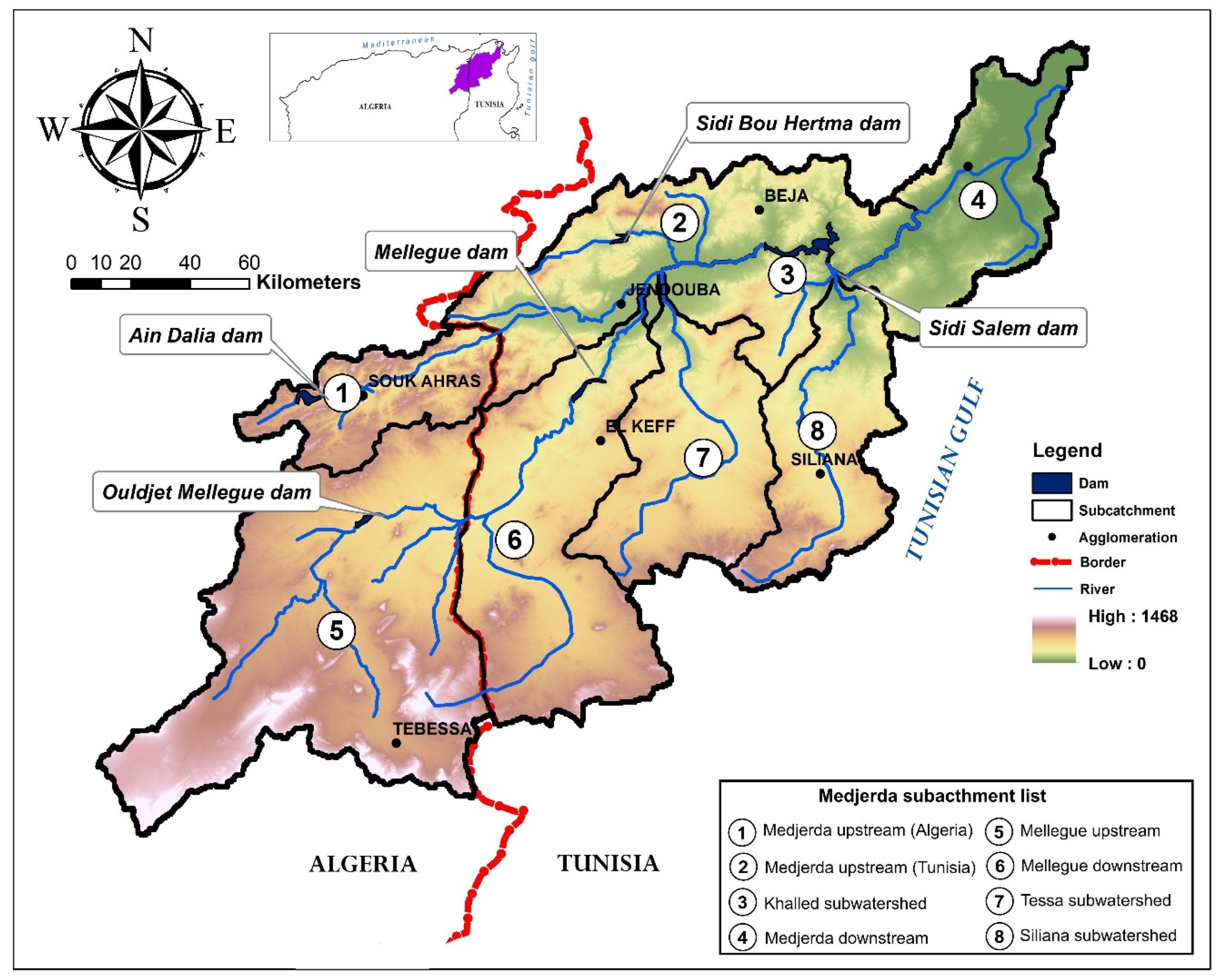
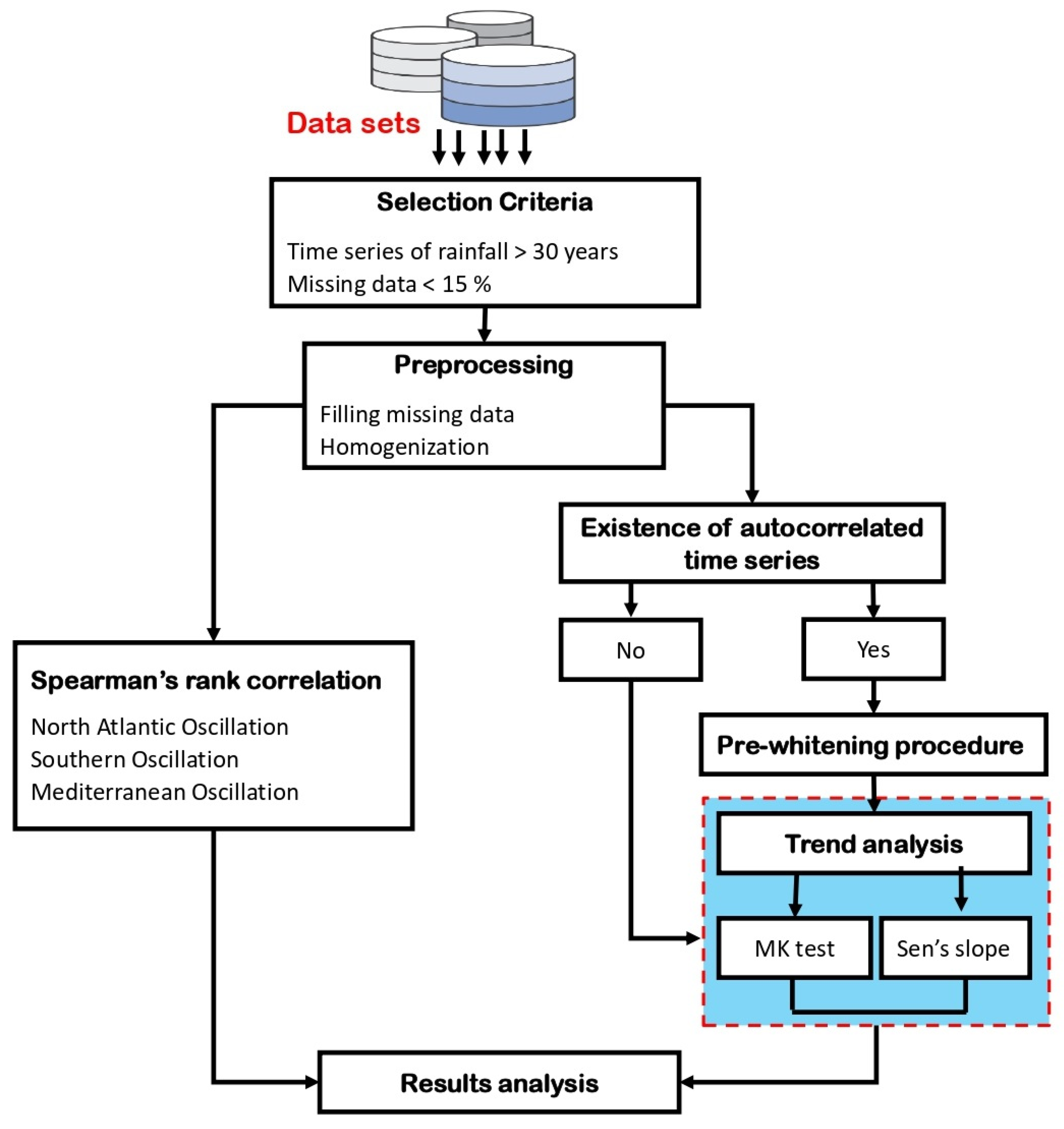
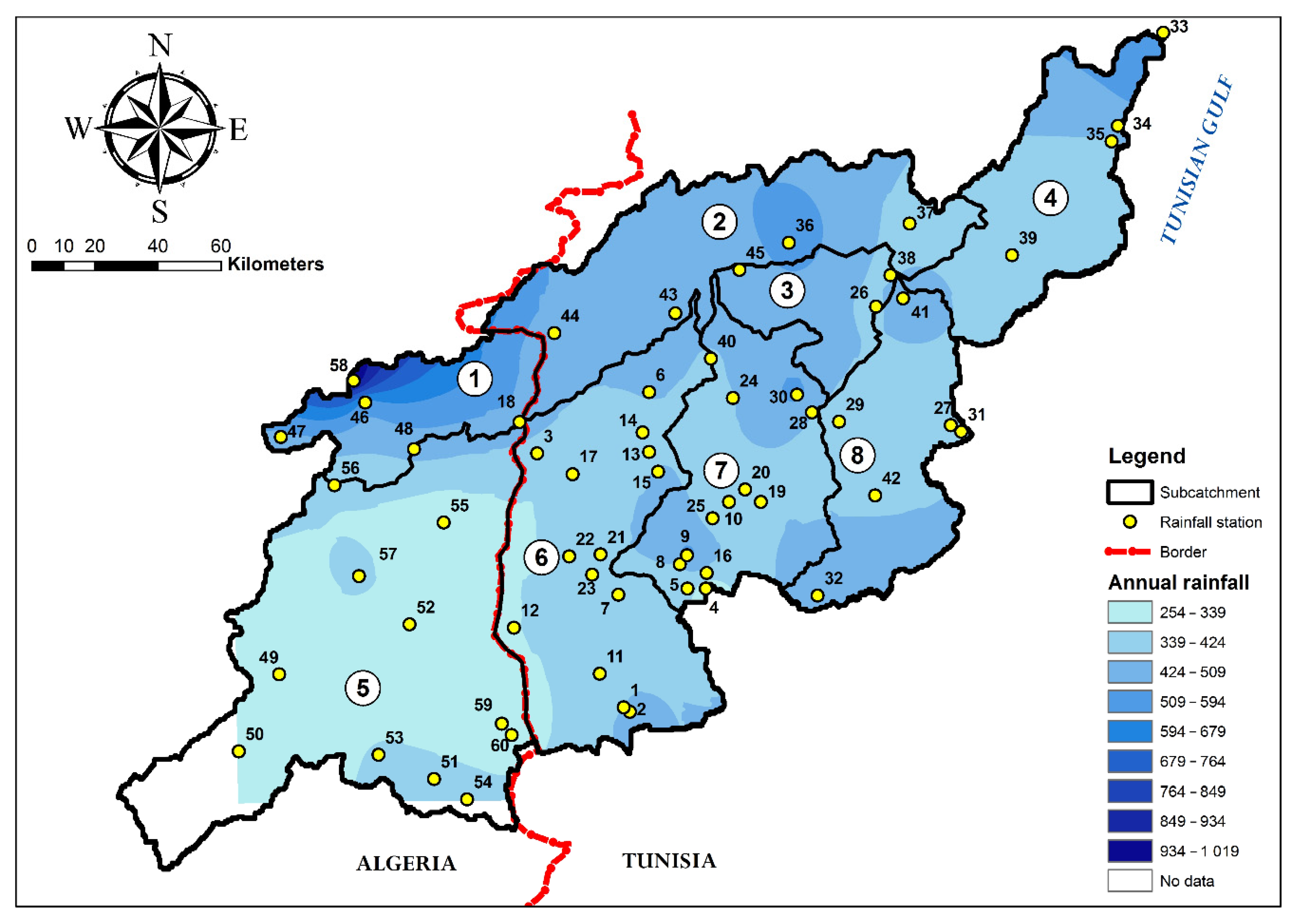
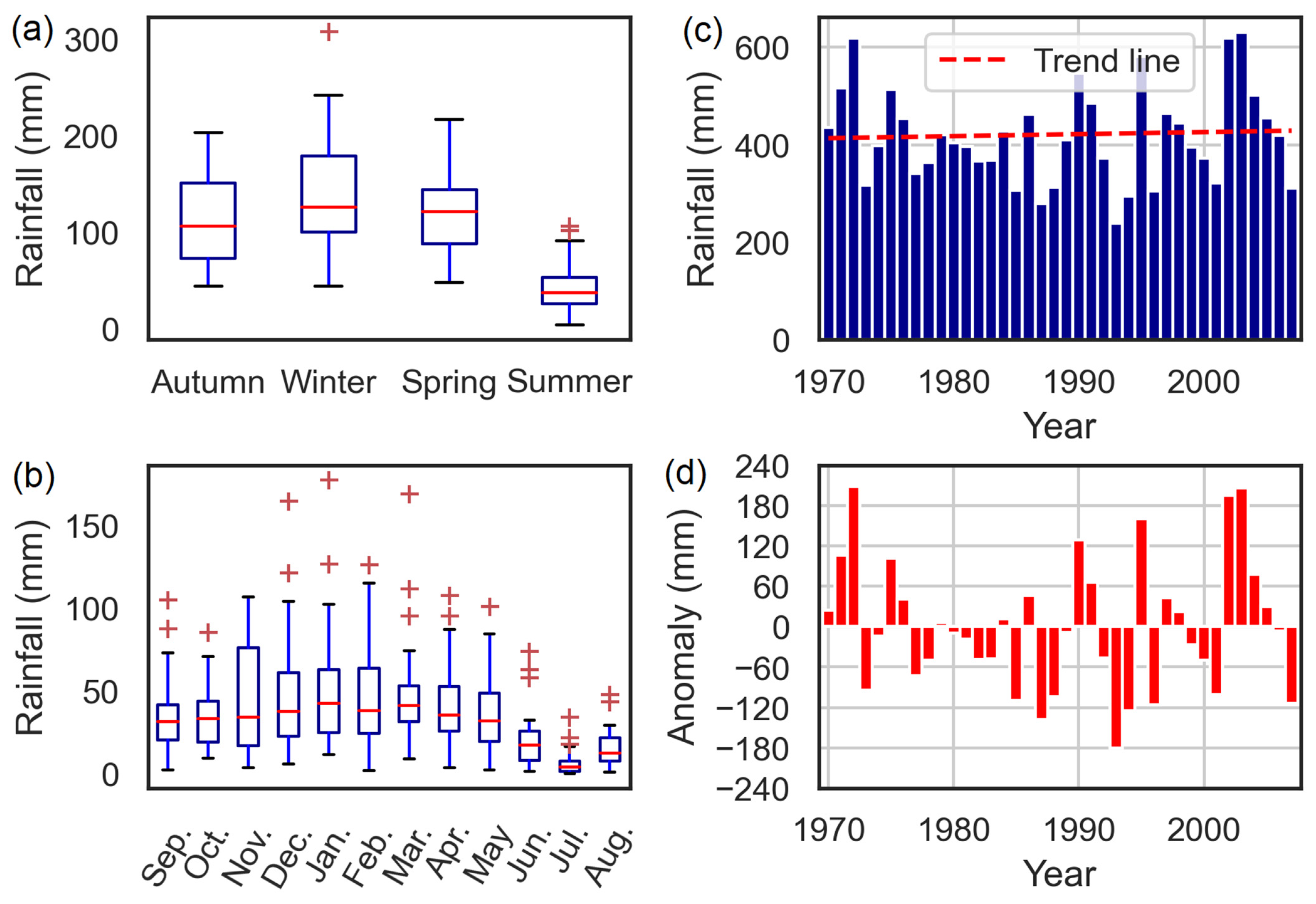



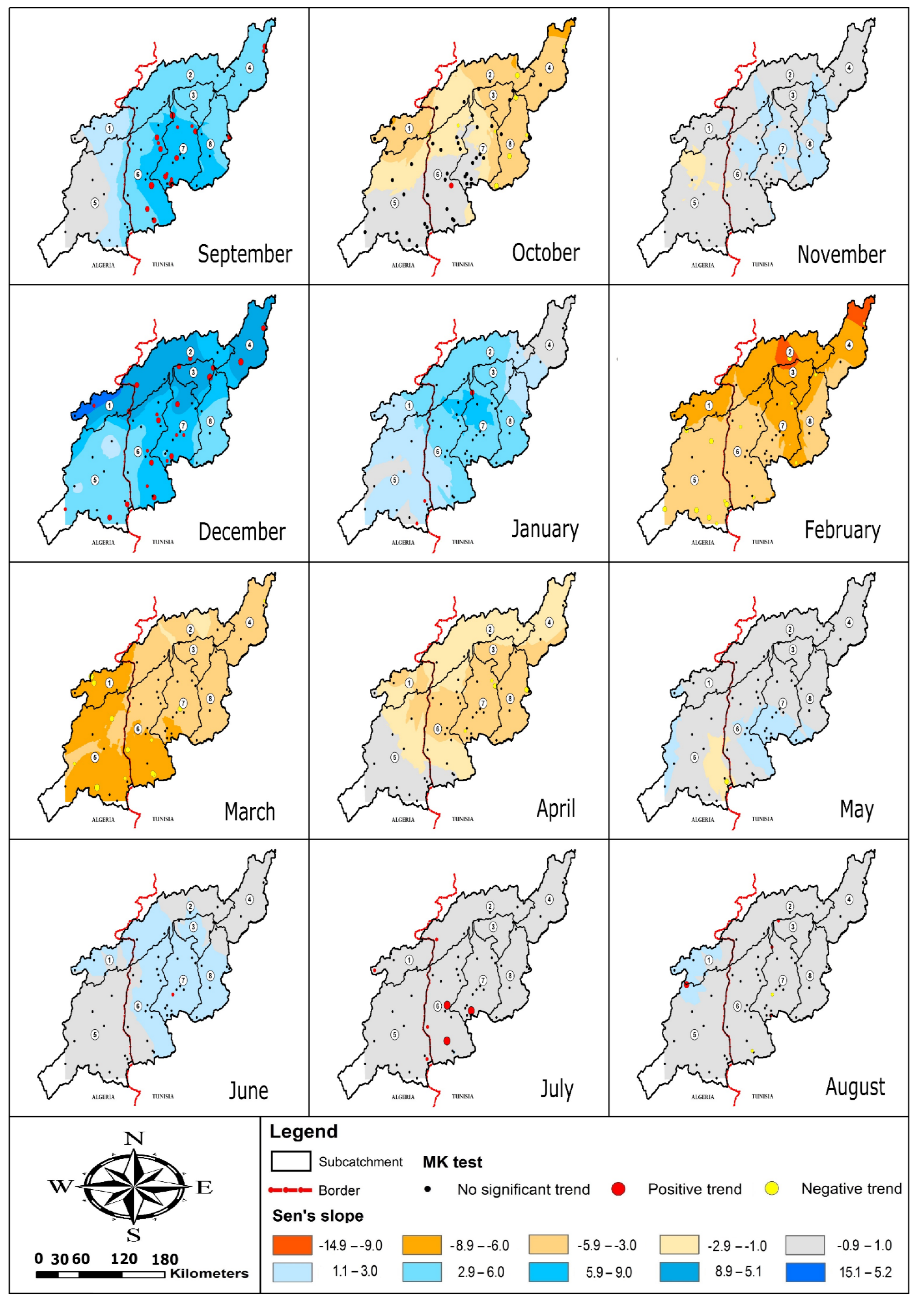
| Station ID | Station Name | Lat. (° N) | Long. (° E) | Alt. (m) | Period | Gaps (%) | Annual Rainfall (mm) | ||
|---|---|---|---|---|---|---|---|---|---|
| Min | Mean | Max | |||||||
| 1 | Tala PF | 35.58 | 8.63 | 889 | 1970–2007 | 3.73 | 253 | 414 | 658 |
| 2 | Tala SM | 35.57 | 8.65 | 1020 | 1970–2007 | 0.00 | 299 | 470 | 793 |
| 3 | Ain Kerma 1 | 36.16 | 8.39 | 601 | 1975–2007 | 0.51 | 192 | 364 | 634 |
| 4 | Ain S’koum1 | 35.85 | 8.87 | 990 | 1970–2007 | 5.48 | 134 | 262 | 431 |
| 5 | Ain Zeligua | 35.85 | 8.82 | 853 | 1974–2007 | 2.94 | 203 | 399 | 661 |
| 6 | Cite du Mellegue SM | 36.31 | 8.71 | 256 | 1970–2007 | 0.00 | 259 | 437 | 744 |
| 7 | Jerissa Delegation | 35.84 | 8.62 | 633 | 1975–2006 | 1.04 | 149 | 344 | 583 |
| 8 | Dehmani Elevage | 35.91 | 8.79 | 652 | 1970–2003 | 5.15 | 227 | 412 | 714 |
| 9 | Dehmani Municipalite | 35.93 | 8.81 | 622 | 1970–2007 | 0.00 | 301 | 541 | 874 |
| 10 | Fath Tessa | 36.05 | 8.93 | 532 | 1977–2007 | 1.08 | 202 | 374 | 696 |
| 11 | Kalaa Khasba | 35.65 | 8.56 | 856 | 1974–2007 | 1.23 | 188 | 387 | 692 |
| 12 | Kalaat Essenam | 35.76 | 8.32 | 623 | 1976–2007 | 0.26 | 144 | 336 | 619 |
| 13 | Kef Birh | 36.17 | 8.71 | 620 | 1972–2007 | 2.78 | 201 | 389 | 647 |
| 14 | Kef Heliopolis | 36.21 | 8.69 | 455 | 1973–2007 | 0.24 | 58 | 357 | 628 |
| 15 | Kef CMA | 36.12 | 8.73 | 491 | 1970–2007 | 0.00 | 236 | 436 | 709 |
| 16 | Ksour Ecole | 35.89 | 8.87 | 720 | 1976–2007 | 0.78 | 266 | 404 | 671 |
| 17 | Oued Mellegue 13 | 36.12 | 8.49 | 324 | 1970–2007 | 0.22 | 126 | 338 | 522 |
| 18 | Sakiet Sidi Youssef SM | 36.24 | 8.34 | 803 | 1970–2007 | 0.00 | 284 | 496 | 834 |
| 19 | Sers Agricole | 36.05 | 9.03 | 501 | 1972–2007 | 0.23 | 227 | 407 | 695 |
| 20 | Sers Delegation | 36.08 | 8.98 | 501 | 1970–2007 | 0.66 | 233 | 401 | 658 |
| 21 | Tajerouine Ain Zouagha | 35.93 | 8.57 | 750 | 1976–2007 | 1.04 | 169 | 406 | 776 |
| 22 | Tajerouine Ferme d’Etat | 35.93 | 8.48 | 511 | 1970–2007 | 0.00 | 132 | 368 | 609 |
| 23 | Tajerouine Agricole | 35.88 | 8.54 | 650 | 1970–2007 | 10.09 | 168 | 386 | 667 |
| 24 | Tessa Sidi Medien | 36.29 | 8.95 | 280 | 1974–2007 | 1.23 | 266 | 418 | 696 |
| 25 | Zouarine Gare | 36.02 | 8.89 | 571 | 1970–2007 | 1.10 | 206 | 388 | 671 |
| 26 | Ain Tounga SE | 36.50 | 9.35 | 110 | 1976–2007 | 0.26 | 216 | 396 | 668 |
| 27 | Ain Guesil | 36.23 | 9.57 | 563 | 1970–2007 | 1.75 | 164 | 365 | 576 |
| 28 | Ain Tabia | 36.26 | 9.17 | 416 | 1970–2007 | 2.85 | 244 | 426 | 819 |
| 29 | Akouat Gare | 36.24 | 9.25 | 350 | 1970–2007 | 0.44 | 189 | 349 | 617 |
| 30 | Krib Ferme Cossem | 36.30 | 9.13 | 447 | 1970–2007 | 0.22 | 336 | 538 | 843 |
| 31 | Ksar Bou Khris | 36.22 | 9.60 | 510 | 1970–2005 | 6.25 | 173 | 425 | 711 |
| 32 | Makthar PF | 35.84 | 9.19 | 900 | 1970–2007 | 0.22 | 255 | 507 | 811 |
| 33 | Porto Farina Ghar El Meleh | 37.13 | 10.18 | 10 | 1970–2007 | 0.00 | 311 | 589 | 988 |
| 34 | Cherfech CRGR | 36.92 | 10.05 | 59 | 1970–2007 | 0.22 | 232 | 480 | 785 |
| 35 | Sidi Thabet Domaine Haras | 36.88 | 10.03 | 14 | 1973–2007 | 0.24 | 173 | 407 | 673 |
| 36 | Beja Inrat | 36.65 | 9.11 | 230 | 1970–2007 | 0.00 | 289 | 573 | 892 |
| 37 | Beauce Tunisienne | 36.69 | 9.45 | 234 | 1970–2002 | 0.00 | 209 | 391 | 588 |
| 38 | Mejez El Bab PF | 36.57 | 9.40 | 142 | 1970–2007 | 0.00 | 191 | 406 | 616 |
| 39 | Montarnaud 1 | 36.62 | 9.74 | 108 | 1975–2007 | 3.03 | 142 | 350 | 597 |
| 40 | Sk El Khemis B.S.CFPA | 36.38 | 8.88 | 146 | 1973–2003 | 5.65 | 204 | 414 | 741 |
| 41 | Testour SM | 36.52 | 9.43 | 112 | 1970–2007 | 0.22 | 255 | 503 | 811 |
| 42 | Siliana Agricole | 36.07 | 9.35 | 431 | 1970–2007 | 5.26 | 185 | 405 | 682 |
| 43 | Jantoura | 36.49 | 8.78 | 390 | 1970–2000 | 0.00 | 298 | 468 | 787 |
| 44 | Gar Dimaou DRE | 36.44 | 8.43 | 195 | 1970–2007 | 0.00 | 239 | 450 | 745 |
| 45 | Bou Salem DRE | 36.59 | 8.96 | 138 | 1970–2007 | 0.22 | 245 | 421 | 700 |
| 46 | Souk Ahras | 36.27 | 7.90 | 590 | 1970–2007 | 3.73 | 170 | 547 | 882 |
| 47 | Khemissa | 36.20 | 7.65 | 845 | 1978–2007 | 5.83 | 250 | 477 | 844 |
| 48 | Taoura | 36.17 | 8.04 | 850 | 1971–2003 | 0.76 | 68 | 461 | 861 |
| 49 | Meskiana | 35.65 | 7.65 | 845 | 1978–2007 | 4.17 | 89 | 253 | 434 |
| 50 | Ain Dhalaa | 35.47 | 7.53 | 953 | 1973–2007 | 14.79 | 106 | 332 | 562 |
| 51 | Tebessa | 35.40 | 8.12 | 890 | 1970–2007 | 0.00 | 185 | 355 | 624 |
| 52 | Boukhadra | 35.75 | 8.03 | 900 | 1970–2007 | 0.00 | 136 | 291 | 514 |
| 53 | Hammamet | 35.45 | 7.95 | 875 | 1971–2007 | 0.00 | 143 | 348 | 638 |
| 54 | Bekkaria | 35.36 | 8.19 | 920 | 1972–2007 | 4.63 | 169 | 374 | 628 |
| 55 | Ouenza | 35.99 | 8.13 | 520 | 1970–2007 | 2.63 | 49 | 273 | 508 |
| 56 | Mdaourouch | 36.08 | 7.82 | 870 | 1970–2007 | 0.22 | 135 | 351 | 700 |
| 57 | Messloula | 35.88 | 7.88 | 660 | 1978–2007 | 12.50 | 133 | 362 | 743 |
| 58 | Ain Seynour | 36.36 | 7.87 | 800 | 1970–2003 | 6.37 | 602 | 1024 | 1486 |
| 59 | Ras El Aioun | 35.54 | 8.28 | 1065 | 1973–2007 | 8.10 | 146 | 301 | 568 |
| 60 | El Kouif | 35.51 | 8.31 | 1015 | 1975–2007 | 8.08 | 91 | 285 | 503 |
| Correlation | < 0.2 | < 0.3 | < 0.4 | ||||||||||||||||
|---|---|---|---|---|---|---|---|---|---|---|---|---|---|---|---|---|---|---|---|
| Oscilliation | NAOi | SOi | MOi | NAOi | SOi | MOi | NAOi | SOi | MOi | ||||||||||
| (+) | (−) | (+) | (−) | (+) | (−) | (+) | (−) | (+) | (−) | (+) | (−) | (+) | (−) | (+) | (−) | (+) | (−) | ||
| Annual | 7 | 0 | 7 | 0 | 5 | 2 | 0 | 0 | 2 | 0 | 0 | 0 | 0 | 0 | 0 | 0 | 0 | 0 | |
| Seasonal | Aut. | 17 | 3 (50) | 0 | 53 | 0 | 45 (50) | 3 | 2 | 0 | 5 | 0 | 8 | 0 | 0 | 0 | 0 | 0 | 2 |
| Win. | 65 (100) | 0 | 0 | 32 (50) | 57 (100) | 0 | 17 (25) | 0 | 0 | 2 | 15 | 0 | 0 | 0 | 0 | 2 | 2 | 0 | |
| Spr. | 2 | 7 | 63 (50) | 0 | 3 | 15 (17) | 0 | 2 | 13 (17) | 0 | 0 | 3 | 0 | 0 | 2 | 0 | 0 | 0 | |
| Sum. | 0 | 13 (40) | 27 (20) | 0 | 8 | 0 | 0 | 5 (20) | 2 | 0 | 0 | 0 | 0 | 2 | 0 | 0 | 0 | 0 | |
| Monthly | September | 2 | 50 (72) | 0 | 0 | 2 | 62 (83) | 0 | 17 (33) | 0 | 0 | 0 | 32 (50) | 0 | 3 (11) | 0 | 0 | 0 | 13 (28) |
| October | 17 (40) | 5 | 2 (10) | 17 | 0 | 10 | 7 (30) | 0 | 0 | 3 | 0 | 2 | 0 | 0 | 0 | 0 | 0 | 0 | |
| November | 53 | 2 | 0 | 87 | 7 | 2 | 2 | 0 | 0 | 48 | 2 | 0 | 0 | 0 | 0 | 7 | 0 | 0 | |
| December | 37 (43) | 2 | 12 (4) | 0 | 0 | 5 | 0 | 2 | 0 | 0 | 0 | 0 | 0 | 0 | 0 | 0 | 0 | 0 | |
| January | 28 (33) | 0 | 0 | 7 | 63 (67) | 0 | 2 | 0 | 0 | 0 | 25 (33) | 0 | 0 | 0 | 0 | 0 | 2 | 0 | |
| Febuary | 0 | 15 (12) | 2 (6) | 13 (12) | 0 | 18 (29) | 0 | 3 (6) | 2 (6) | 10 (6) | 0 | 2 (6) | 0 | 0 | 0 | 2 | 0 | 2 (6) | |
| March | 8 (7) | 0 | 12 (20) | 2 | 12 (7) | 8 (7) | 0 | 0 | 3 (7) | 0 | 5 (7) | 0 | 0 | 0 | 0 | 0 | 0 | 0 | |
| April | 0 | 65 (80) | 28 (40) | 0 | 3 | 28 (40) | 0 | 23 (40) | 8 | 0 | 0 | 17 (20) | 0 | 0 | 0 | 0 | 0 | 2 | |
| May | 47 | 3 | 3 | 5 | 10 | 5 | 27 | 0 | 0 | 0 | 0 | 0 | 5 | 0 | 0 | 0 | 0 | 0 | |
| June | 25 | 2 | 2 | 13 | 20 | 5 | 5 | 2 | 0 | 0 | 0 | 0 | 0 | 0 | 0 | 0 | 0 | 0 | |
| July | 7 | 3 (14) | 52 (57) | 0 | 17 (43) | 2 | 2 | 0 | 22 (43) | 0 | 3 (14) | 0 | 0 | 0 | 5 (14) | 0 | 0 | 0 | |
| August | 2 | 12 | 10 | 8 | 0 | 40 (60) | 0 | 5 | 5 | 0 | 0 | 15 | 0 | 0 | 0 | 0 | 0 | 5 | |
Publisher’s Note: MDPI stays neutral with regard to jurisdictional claims in published maps and institutional affiliations. |
© 2022 by the authors. Licensee MDPI, Basel, Switzerland. This article is an open access article distributed under the terms and conditions of the Creative Commons Attribution (CC BY) license (https://creativecommons.org/licenses/by/4.0/).
Share and Cite
Boulmaiz, T.; Boutaghane, H.; Abida, H.; Saber, M.; Kantoush, S.A.; Tramblay, Y. Exploring the Spatio-Temporal Variability of Precipitation over the Medjerda Transboundary Basin in North Africa. Water 2022, 14, 423. https://doi.org/10.3390/w14030423
Boulmaiz T, Boutaghane H, Abida H, Saber M, Kantoush SA, Tramblay Y. Exploring the Spatio-Temporal Variability of Precipitation over the Medjerda Transboundary Basin in North Africa. Water. 2022; 14(3):423. https://doi.org/10.3390/w14030423
Chicago/Turabian StyleBoulmaiz, Tayeb, Hamouda Boutaghane, Habib Abida, Mohamed Saber, Sameh A. Kantoush, and Yves Tramblay. 2022. "Exploring the Spatio-Temporal Variability of Precipitation over the Medjerda Transboundary Basin in North Africa" Water 14, no. 3: 423. https://doi.org/10.3390/w14030423
APA StyleBoulmaiz, T., Boutaghane, H., Abida, H., Saber, M., Kantoush, S. A., & Tramblay, Y. (2022). Exploring the Spatio-Temporal Variability of Precipitation over the Medjerda Transboundary Basin in North Africa. Water, 14(3), 423. https://doi.org/10.3390/w14030423







